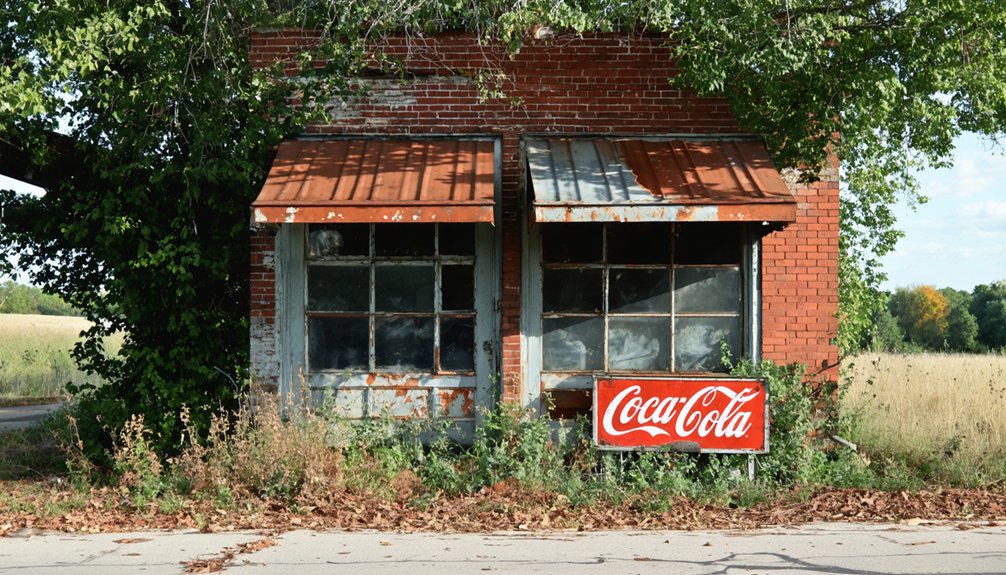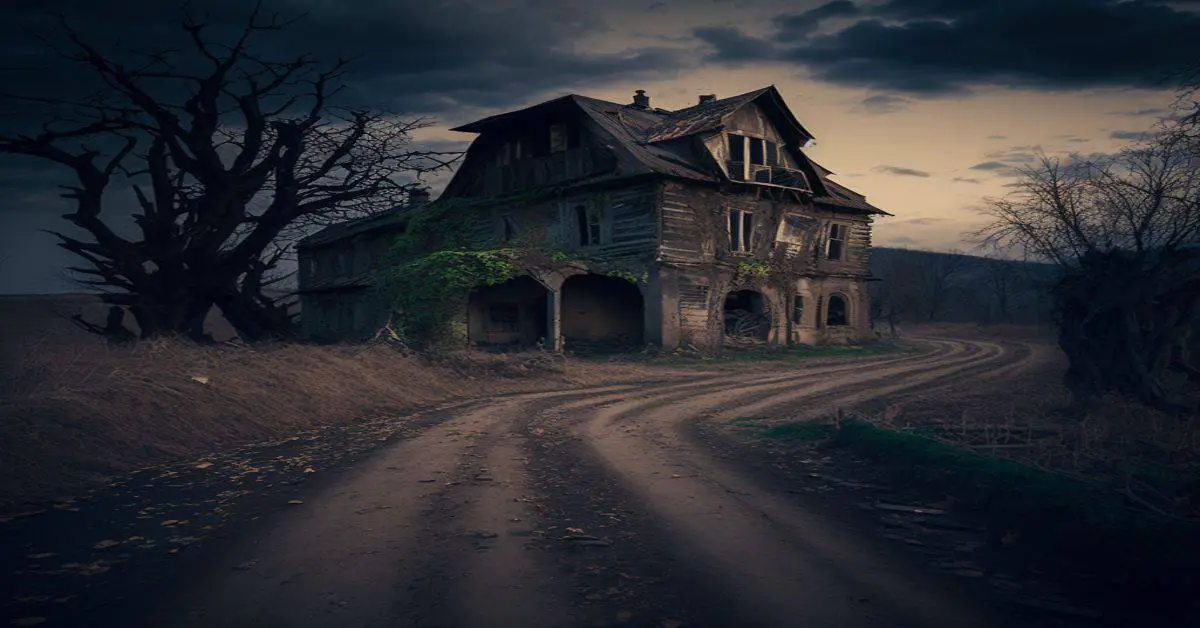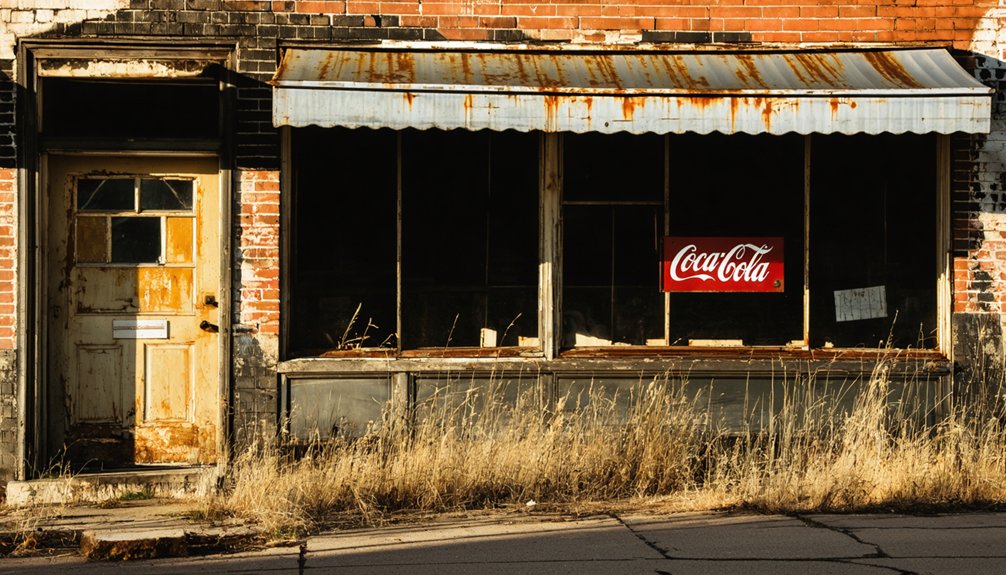You’ll find the ghostly remnants of Brownsville along the Big Muddy River in southern Illinois, where Dr. Conrad Will founded Jackson County’s first seat of government in 1816. The once-bustling frontier town grew into Illinois’ third-largest settlement before a devastating courthouse fire in 1843 sparked its decline. Today, archaeological sites and historical markers dot the landscape where residents dismantled their homes to rebuild in nearby Murphysboro, leaving behind a remarkable tale of frontier rise and fall.
Key Takeaways
- Brownsville was Illinois’ third-largest town in the early 1800s before becoming a ghost town following its decline in 1843.
- Originally established in 1816 by Dr. Conrad Will, Brownsville served as Jackson County’s first seat of government.
- A devastating courthouse fire in 1843 destroyed vital records and marked the beginning of Brownsville’s abandonment.
- Residents dismantled and relocated their buildings to nearby Murphysboro, which became the new county seat.
- Archaeological remains and historical markers now identify the ghost town’s location near the Big Muddy River.
The Rise of an Early Illinois Settlement (1815-1843)
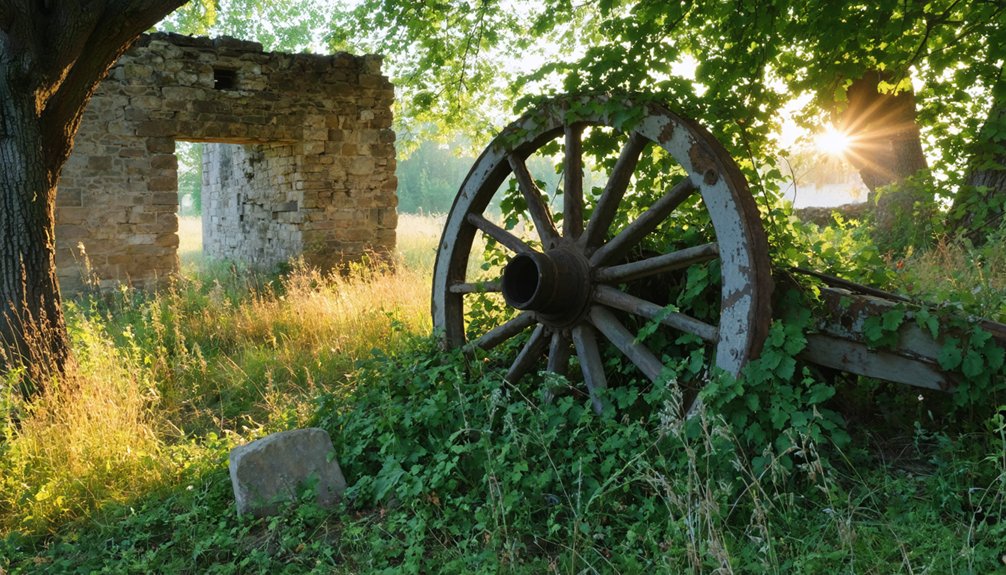
While many frontier settlements struggled to gain prominence in early Illinois, Brownsville emerged as a significant regional center following its establishment in 1816.
You’ll find its origins tied to Dr. Conrad Will, who donated 20 acres near his salt works on the Big Muddy River. The pioneer settlement quickly gained importance, becoming Jackson County’s first seat of government in 1817. The location was situated on the north bank of the Big Muddy River.
Despite its challenging location off main travel routes, Brownsville grew into Illinois’ third-largest town and a crucial regional hub. The courthouse and salt works transformed it into a bustling center of legal, political, and economic activity. Early community gatherings featured muster gatherings that brought residents together for military training and social events.
The town’s influence extended throughout Jackson County until 1835, when Dr. Will’s death marked the beginning of its decline. Changing population patterns and economic shifts eventually led to its downfall.
Life Along the Big Muddy River
The Big Muddy River shaped life in early Jackson County, stretching 94 miles from Marion County to the Mississippi River and serving as an essential artery for the region’s development.
Originally known as Riviere au Vase, French traders first established the river’s importance as a commercial route. You’d have found bustling river commerce along its banks, from French fur traders at Native American camps to flatboats heading to New Orleans. The river fostered vibrant community gatherings at places like Brownsville, where salt works, stores, and tanneries thrived under pioneers like Dr. Conrad Will. By 1843, the once booming river town declined significantly.
You could’ve witnessed the ambitious attempts to improve navigation through the Avause River Navigation Company‘s $25,000 investment in dams and locks.
While the river’s navigability remained challenging, it continued drawing people together through seasonal festivals and social activities, creating lasting bonds that shaped Jackson County’s early identity, even as Brownsville’s prominence eventually faded.
From County Seat to Abandoned Ground
Founded in 1816 through Dr. Conrad Will’s land donation, Brownsville rapidly grew into Illinois’ third-largest town and first Jackson County seat.
You’ll find that Will’s entrepreneurial spirit drove the Brownsville economy through his diverse enterprises, including a grist mill, tannery, and salt works.
The town’s decline began after prominent citizens departed and newer settlements emerged.
When the courthouse burned down, Dr. Logan’s offer of land for a new county seat sealed Brownsville’s fate. The January 1843 fire completely destroyed the original courthouse, marking a turning point in the town’s history.
You can trace the town’s final days as residents dismantled their homes and businesses, relocating them to the newly established Murphysboro.
The shift proved swift and decisive – within years, this once-thriving hub had vanished, leaving only its cemetery and archaeological remains as evidence of its former significance in Illinois’ early development.
The Devastating Courthouse Fire
On a frigid January night in 1843, disaster struck Brownsville’s two-story courthouse as flames engulfed the frame building shortly after midnight.
Similar to the 1872 fire that would later destroy Vermillion County’s courthouse, this blaze proved catastrophic for the community.
The fire’s aftermath revealed the community’s desperate attempts to save their civic center, but despite their efforts, only County Clerk D. H. Brush managed to rescue a few precious records.
The devastating event unfolded in four crucial stages:
- The fire spread rapidly through the wooden structure, consuming essential documents.
- Community members rushed to battle the blaze but couldn’t contain it.
- County officials later decided against rebuilding due to flood risks.
- The loss became a symbolic funeral pyre for Brownsville’s prominence.
This display of community resilience wasn’t enough to save the town’s status as county seat, marking a turning point in Brownsville’s decline toward its eventual ghost town fate. The tragedy prompted officials to establish Murphysboro as the new county seat.
Migration to Murphysboro
When you trace the migration from Brownsville to Murphysboro in 1843, you’ll find that many residents dismantled their homes and businesses for relocation to the new county seat.
You can discover evidence that entire structures were carefully taken apart, transported piece by piece, and reconstructed in Murphysboro to preserve valuable building materials.
The community’s determination to salvage and reuse their property demonstrates how the forced relocation, while disruptive, became an organized effort to preserve both material resources and social connections in the new settlement.
This significant move occurred after a devastating courthouse fire prompted officials to establish Murphysboro as the new county seat.
The area’s dense hardwood forests provided abundant building materials that made such a large-scale relocation of structures possible.
Forced Relocation Process
As the decision to relocate Jackson County’s seat gained momentum in 1843, residents of Brownsville faced a significant change that would reshape their lives and community.
Similar to many other instances requiring place name disambiguation, historical records of Brownsville’s relocation needed careful documentation to distinguish it from other locations sharing the name.
The relocation logistics involved a complex process that fundamentally changed the region’s landscape.
During this change, you’d have witnessed:
- The dismantling and physical movement of several buildings from Brownsville to the newly established Murphysboro
- A mass exodus of residents following the courthouse fire, seeking opportunities in the more centrally located settlement
- The transfer of businesses and services to Dr. John Logan’s donated twenty acres
- The systematic abandonment of Brownsville as community members relocated their homes and livelihoods
This forced relocation marked the end of Brownsville’s prominence and solidified Murphysboro’s position as Jackson County’s new center of commerce and governance.
Property Rebuilding and Reuse
The physical transformation of Brownsville into Murphysboro began through a carefully orchestrated process of building relocation and property reuse in 1843.
You’ll find that many residents chose to preserve their investments by dismantling and reconstructing their buildings in the new town, rather than abandoning them completely.
Through coordinated property relocation efforts, families moved entire structures westward to Murphysboro, where Dr. John Logan’s land donation provided fresh opportunities.
Business owners, craftsmen, and pioneers transferred their operations while maintaining essential community connections.
The building preservation campaign guaranteed that Brownsville’s log houses and commercial structures found new life in Murphysboro’s growing streetscape.
Meanwhile, the old town site gradually returned to nature, with only the cemetery remaining as a memorial to its former existence.
Archaeological Remnants and Historical Markers
If you’re interested in exploring Brownsville’s remains, you’ll find historical markers precisely identifying the ghost town’s location near the Big Muddy River and Salt Creek, approximately 3.25 miles west of Murphysboro.
Archaeological excavations have unearthed foundations and period artifacts, including iron kettles from Dr. Conrad Will’s salt works, though many original structures were dismantled when residents relocated.
The site’s open fields now preserve opportunities for further archaeological study, while interpretive markers document Brownsville’s significance as Jackson County’s first county seat and its eventual abandonment following the courthouse fire of 1843.
Site Excavation Opportunities
Despite challenging archaeological conditions, Brownsville’s excavation opportunities remain largely unexplored due to several limiting factors.
You’ll find that flooding, site instability, and limited historical records present significant excavation challenges.
However, there’s potential for future archaeological work if proper funding opportunities are secured.
Consider these key steps for developing excavation initiatives:
- Partner with archaeological institutions to conduct preliminary site surveys
- Apply for research grants to support systematic excavation efforts
- Establish community-driven preservation programs to protect potential dig sites
- Create detailed documentation systems to record any future findings
The lack of current excavations doesn’t diminish Brownsville’s historical significance.
With the right resources and community support, you can help uncover valuable insights about this early Illinois settlement that served as Jackson County’s first seat.
Historical Marker Locations
While excavation opportunities remain limited, physical markers and archaeological remnants offer tangible connections to Brownsville’s past.
You’ll find historical markers placed strategically along public roads near the original town site, commemorating key figures like Conrad Will and significant events including the courthouse fire of 1843. The marker significance extends beyond mere location identification, providing insights into Brownsville’s role as Jackson County’s first seat and Illinois’ third-largest settlement.
For the ideal visitor experience, you should note that the site lacks modern infrastructure.
While you can access the markers from public roads, the actual town remnants lie mostly underground on private land.
You’ll discover subtle surface artifacts and foundation traces that help reconstruct the vanished town’s layout, though no original buildings remain standing.
Legacy in Southern Illinois History
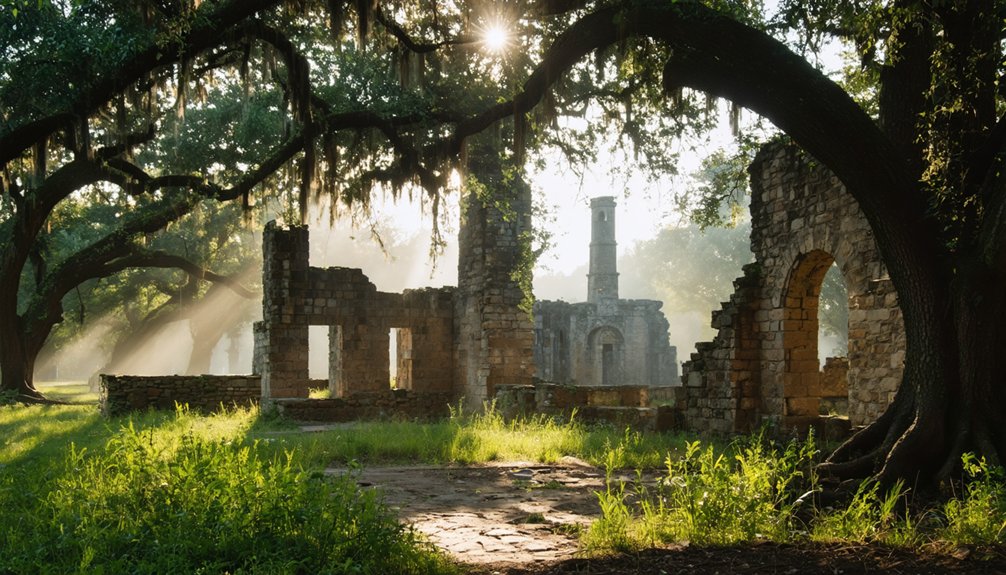
A pivotal chapter in southern Illinois history, Brownsville’s legacy endures through its role as Jackson County’s first administrative center and as a demonstration to early frontier development.
The town’s impact on community governance and early trade shaped the region’s growth despite its eventual decline.
Though Brownsville faded into history, its pioneering influence on local governance and commerce left an indelible mark on southern Illinois’s development.
You’ll find Brownsville’s lasting influence reflected in:
- Its pioneering role in establishing local government structures that formed the foundation for Jackson County’s modern administrative systems
- The resourceful spirit of its residents who literally moved their town, relocating buildings to Murphysboro
- Its demonstration of how river-based commerce shaped early settlement patterns in southern Illinois
- The archaeological significance of its remains, which continue to provide insights into frontier life and early American development
Though the physical town vanished, Brownsville’s contribution to southern Illinois’s development remains an essential part of the region’s identity.
Frequently Asked Questions
Were There Any Notable Crimes or Outlaws in Brownsville’s History?
You won’t find any outlaw legends or significant crime history, as surviving records show mainly routine legal matters before the 1843 courthouse fire destroyed most detailed documentation.
What Happened to the Graves and Cemeteries When Brownsville Was Abandoned?
Like a needle in a haystack, you’d be hard-pressed to find detailed records about grave relocation or cemetery preservation. Historical documents don’t clearly show whether graves were moved or left behind.
Did Any Native American Tribes Live in the Brownsville Area?
You’ll find the Kaskaskia tribe, part of the Illinois Confederation, controlled this area’s Native cultural heritage, though they’d left by the 1800s due to conflicts and forced displacement.
What Was the Estimated Peak Population of Brownsville Before Its Decline?
You’ll find historical records showing Brownsville’s population peaked at 400-500 residents during its early significance as Illinois’ third-largest town, before experiencing decline following Dr. Will’s death and courthouse relocation.
Were There Any Documented Epidemics or Diseases That Affected Brownsville’s Residents?
You won’t find documented epidemic outbreaks in Brownsville’s records. While disease impact likely occurred, the courthouse fire of 1843 destroyed health records, and surviving sources don’t mention specific health crises.
References
- https://drloihjournal.blogspot.com/2022/08/lost-towns-of-illinois-brownsville-illinois.html
- https://en.wikipedia.org/wiki/Brownsville
- https://jackson.illinoisgenweb.org/histories/brownsville.html
- https://www.youtube.com/watch?v=93k0qtvzkn4
- https://kids.kiddle.co/Brownsville
- https://www.youtube.com/watch?v=dZCDMixgRDg
- https://www.hmdb.org/m.asp?m=160951
- https://stampedes.dickinson.edu/place/brownsville-il
- https://archive.org/download/settlementofilli00pool/settlementofilli00pool.pdf
- https://libsysdigi.library.illinois.edu/OCA/Books2012-06/historyofjohnson00chap/historyofjohnson00chap.pdf
